Effect of the Soft and Hard Interbedded Layers of Bedrock on the Mechanical Characteristics of Stabilizing Piles
Abstract
:1. Introduction
2. Laboratory Investigation of the Effect of a Landslide on Stabilizing Piles
2.1. Material Parameters
2.2. Experimental Model
2.3. Production of the Experimental Materials
2.4. Analysis of the Test Model Results
3. Numerical Modeling and Comparison with Experimental Results
4. Numerical Study Considering the Presence of the Soft and Hard Interbedded Bedrock Layer
4.1. Model Establishment and Parameter Selection
4.2. The Influence of Different Lithology Bedrock Layers on the Stabilizing Pile
4.3. Effect of the Dip Angle of Soft and Hard Interbedded Bedrock Layer on Stabilizing Piles
5. Conclusions
Author Contributions
Funding
Acknowledgments
Conflicts of Interest
References
- Li, C.D.; Wang, L.Q.; Jing, H.Y.; Liu, Q.T. Protection control scheme and evaluation of effects on pipeline crossing beneath landslide area. J. Pipeline Syst. Eng. Pract. 2013, 4, 41–48. [Google Scholar] [CrossRef]
- Zhu, H.H.; Shi, B.; Yan, J.F.; Zhang, J.; Zhang, C.C.; Wang, B.J. Fiber Bragg grating-based performance monitoring of a slope model subjected to seepage. Smart Mater. Struct. 2014, 23, 095027. [Google Scholar] [CrossRef]
- Zhu, H.H.; Shi, B.; Yan, J.F.; Zhang, J.; Wang, J. Investigation of the evolutionary process of a reinforced model slope using a fiber-optic monitoring network. Eng. Geol. 2015, 186, 34–43. [Google Scholar] [CrossRef]
- Li, C.D.; Wang, X.Y.; Tang, H.M.; Lei, G.P.; Yan, J.F.; Zhang, Y.Q. A preliminary study on the location of the stabilizing piles for colluvial landslides with interbedding hard and soft bedrocks. Eng. Geol. 2017, 224, 15–28. [Google Scholar] [CrossRef]
- Ashour, M.; Ardalan, H. Analysis of pile stabilized slopes based on soil-pile interaction. Comput. Geotech. 2012, 39, 85–97. [Google Scholar] [CrossRef]
- Zhu, H.H.; Ho, A.N.L.; Yin, J.H.; Sun, H.W.; Pei, H.F.; Hong, C.Y. An optical fibre monitoring system for evaluating the performance of a soil nailed slope. Smart Struct. Syst. 2012, 9, 393–410. [Google Scholar] [CrossRef]
- Sun, S.W.; Zhu, B.Z.; Wang, J.C. Design method for stabilization of earth slopes with micropiles. Soils Found. 2013, 53, 487–497. [Google Scholar] [CrossRef] [Green Version]
- Ito, T.; Matsui, T. Methods to estimate lateral force acting on stabilizing piles. Soils Found. 1975, 15, 43–59. [Google Scholar] [CrossRef] [Green Version]
- Viggiani, C. Ultimate Lateral Load on Piles Used to Stabilize Landslides. In Proceedings of the 10th International Conference on Soil Mechanics and Foundation Engineering, Stockholm, Sweden, 15–19 June 1981; pp. 555–560. [Google Scholar]
- Reese, L.C.; Wang, S.T.; Fouse, J.L. Use of Drilled Shafts in Stabilizing a Slope. In Proceedings of Stability and Performance of Slopes and Embankments II; The American Society of Civil Engineers (ASCE): Reston, VA, USA, 1992; pp. 1318–1332. [Google Scholar]
- Lee, C.Y.; Hull, T.S.; Poulos, H.G. Simplified pile-slope stability analysis. Comput. Geotech. 1995, 17, 1–16. [Google Scholar] [CrossRef]
- Won, J.; You, K.; Jeong, S.; Kim, S. Coupled effects in stability analysis of pile-slope systems. Comput. Geotech. 2005, 32, 304–315. [Google Scholar] [CrossRef]
- Kahyaoğlu, M.R.; Onal, O.; Imançl, G.; Ozden, G.; Kayalar, A.Ş. Soil arching and load transfer mechanism for slope stabilized with piles. J. Civ. Eng. Manag. 2012, 18, 701–708. [Google Scholar] [CrossRef] [Green Version]
- Sánchez, M.; Roesset, J.M. Evaluation of models for laterally loaded piles. Comput. Geotech. 2013, 48, 316–320. [Google Scholar] [CrossRef]
- Gu, M.; Kong, L.G.; Chen, R.P.; Chen, Y.M.; Bian, X.C. Response of 1 × 2 pile group under eccentric lateral loading. Comput. Geotech. 2014, 57, 114–121. [Google Scholar] [CrossRef]
- Wang, L.; Hu, W.; Sun, D.A.; Li, L. Stability of Unsaturated Soil Slopes with Cracks under Steady Infiltration. Comput. Geotech. 2019, 43, 1184–1206. [Google Scholar] [CrossRef]
- Ni, P.; Mei, G.; Zhao, Y. Influence of raised groundwater level on the stability of unsaturated soil slopes. Int. J. Geomech. 2018, 18, 04018168. [Google Scholar] [CrossRef]
- Frank, R.; Pouget, P. Experimental pile subjected to long duration thrusts owing to a moving slope. Geotechnique 2008, 58, 645–658. [Google Scholar] [CrossRef]
- Kang, G.C.; Song, Y.S.; Kim, T.H. Behavior and stability of a large-scale cut slope considering reinforcement stages. Landslides 2009, 6, 263–272. [Google Scholar] [CrossRef]
- Song, Y.S.; Hong, W.; Woo, K. Behaviour and analysis of stabilizing piles installed in a cut slope during heavy rainfall. Eng. Geol. 2012, 129–130, 56–67. [Google Scholar] [CrossRef]
- Lirer, S. Landslide stabilizing piles: Experimental evidences and numerical interpretation. Eng. Geol. 2012, 149–150, 70–77. [Google Scholar] [CrossRef]
- Nunez, M.A.; Briançon, L.; Dias, D. Analyses of a pile-supported embankment over soft clay: Full-scale experiment, analytical and numerical approaches. Eng. Geol. 2013, 153, 53–67. [Google Scholar] [CrossRef]
- Li, C.D.; Tang, H.M.; Ge, Y.F.; Hu, X.L.; Wang, L.Q. Application of back-propagation neural network on bank destruction forecasting for accumulative landslides in the Three Gorges Reservoir Region, China. Stoch. Environ. Res. Risk Assess. 2014, 28, 1465–1477. [Google Scholar] [CrossRef]
- Ni, P.; Wang, S.; Zhang, S.; Mei, L. Response of heterogeneous slopes to increased surcharge load. Comput. Geotech. 2016, 78, 99–109. [Google Scholar] [CrossRef]
- Martin, G.R.; Chen, C.Y. Response of piles due to lateral slope movement. Comput. Struct. 2005, 83, 588–598. [Google Scholar] [CrossRef]
- Conte, E.; Troncone, A.; Vena, M. Nonlinear three-dimensional analysis of reinforced concrete piles subjected to horizontal loading. Comput. Geotech. 2013, 49, 123–133. [Google Scholar] [CrossRef]
- Salgado, R.; Tehrani, F.S.; Prezzi, M. Analysis of laterally loaded pile groups in multilayered elastic soil. Comput. Geotech. 2014, 62, 136–153. [Google Scholar] [CrossRef]
- Lei, G.P.; Tang, H.M.; Wu, W. A pile–soil separation concerned model for laterally loaded piles in layered soils. In Recent Advances in Modeling Landslides and Debris Flows; Springer Series in Geomechanics and Geoengineering; Springer: Cham, Switzerland, 2015; pp. 211–228. [Google Scholar]
- Dong, M.M.; Wang, L.Q.; Ge, Y.F.; Wang, C. Mechanical characteristics of anti-sliding pile considering comprehensive foundation coefficient of sliding bed on composite inclined rock mass. Rock Soil Mech. 2017, 38, 3000–3008. [Google Scholar]
- Guo, W.D. Nonlinear response of laterally loaded rigid piles in sliding soil. Can. Geotech. J. 2015, 52, 903–925. [Google Scholar] [CrossRef] [Green Version]
- Pan, J.L.; Goh, A.T.C.; Wong, K.S.; Teh, C.I. Ultimate soil pressures for piles subjected to lateral soil movements. J. Geotech. Geoenviron. 2002, 128, 530–535. [Google Scholar] [CrossRef]
- Zomorodian, S.M.A.; Dehghan, M. Lateral resistance of a pile installed near a reinforced slope. Int. J. Phys. Model. Geotech. 2011, 11, 156–165. [Google Scholar] [CrossRef]
- Chenaf, N.; Chazelas, J.L.; Escoffier, S.; Pecker, A. Independent experimental observations of kinematic and inertial soil-pile interactions. Int. J. Phys. Model. Geotech. 2012, 12, 1–14. [Google Scholar] [CrossRef]
- Wang, L.P.; Zhang, G. Centrifuge model test study on pile reinforcement behavior of cohesive soil slopes under earthquake conditions. Landslides 2014, 11, 213–223. [Google Scholar] [CrossRef]
- Tang, H.M.; Hu, X.L.; Xu, C.; Li, C.D.; Yong, R.; Wang, L.Q. A novel approach for determining landslide pushing force based on landslide–pile interactions. Eng. Geol. 2014, 182, 15–24. [Google Scholar] [CrossRef]
- Cai, F.; Ugai, K. Numerical Analysis of the Stability of a Slope Reinforced with Piles. Soils Found. 2000, 40, 73–84. [Google Scholar] [CrossRef] [Green Version]
- Jeong, S.; Kim, B.; Won, J.; Lee, J. Uncoupled analysis of stabilizing piles in weathered slopes. Comput. Geotech. 2003, 30, 671–682. [Google Scholar] [CrossRef]
- Jiang, X.; Liu, J.N.; Huang, M.X.; Qiu, Y.J. Numerical simulation of embankment on sloped weak ground reinforced by anti-slide piles. Rock Soil Mech. 2011, 32, 3679–3684. [Google Scholar]
- Wei, W.B.; Cheng, Y.M. Strength reduction analysis for slope reinforced with one row of piles. Comput. Geotech. 2009, 36, 1176–1185. [Google Scholar] [CrossRef]
- Sun, D.A.; Wang, L.; Li, L. Three-dimensional stability of compound slope using limit analysis method. Can. Geotech. J. 2019, 56, 116–125. [Google Scholar]
- Yong, R. Interaction between Thrust Load Caused Landslide and Antislide Pile in Jurassic Strata in Three Gorges Reservoir Region. Ph.D. Thesis, China University of Geosciences, Wuhan, China, 2014. [Google Scholar]
- Ma, J.; Tang, H.; Hu, X.; Bobet, A.; Zhang, M.; Zhu, T. Identification of causal factors for the Majiagou landslide using modern data mining methods. Landslides 2017, 14, 311–322. [Google Scholar] [CrossRef]
- Li, C. Plane Arrangement and Structure Optimization of Stabilizing Piles for Landslides Developing in Jurassic Strata of Three Gorges Reservior Region; China University of Geosciences Press: Wuhan, China, 2015. [Google Scholar]
- Li, C.; Wu, J.; Tang, H.; Hu, X.; Liu, X.; Wang, C.; Liu, T.; Zhang, Y. Model testing of the response of stabilizing piles in landslides with upper hard and lower weak bedrock. Eng. Geol. 2016, 204, 65–76. [Google Scholar] [CrossRef]

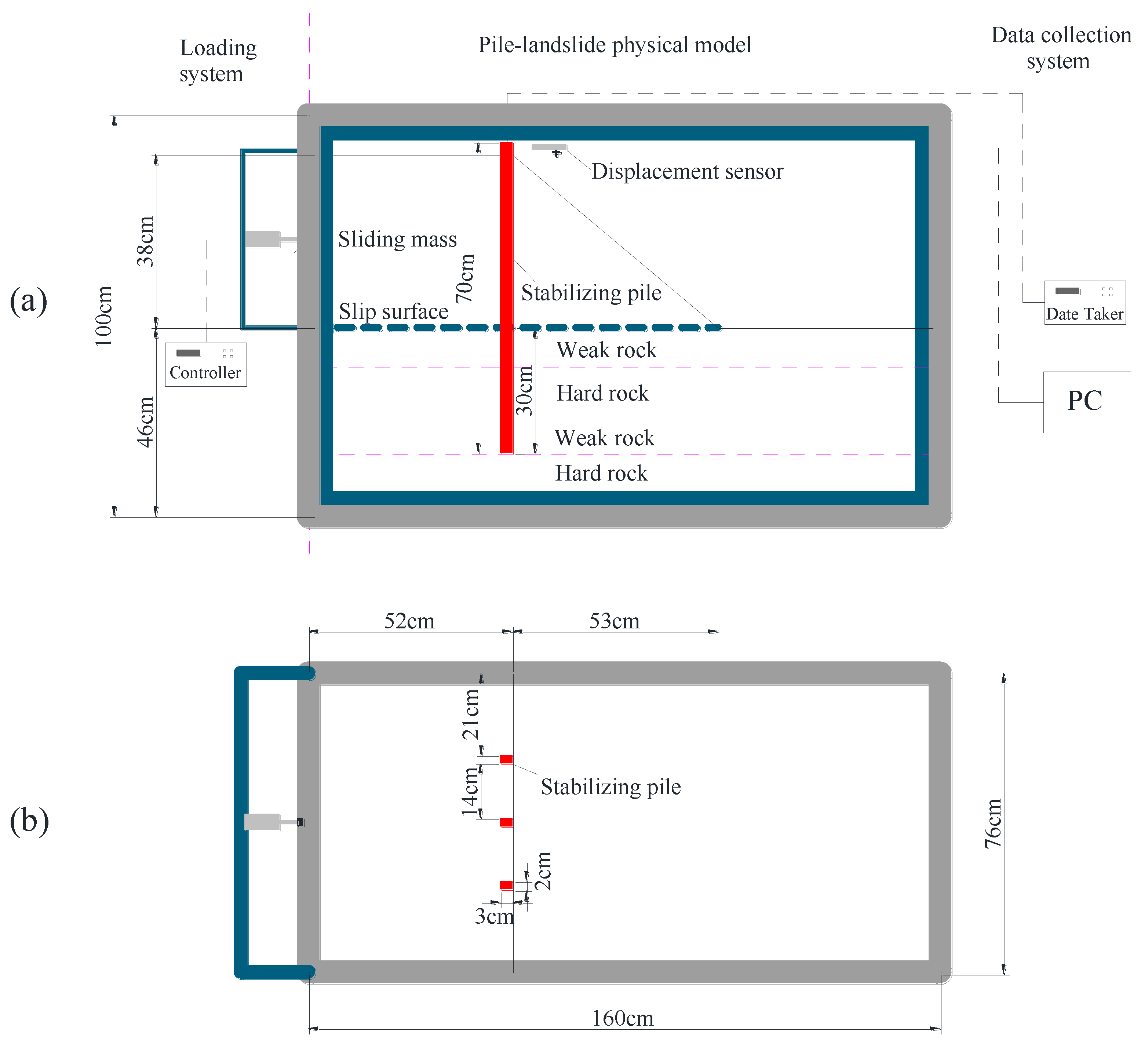

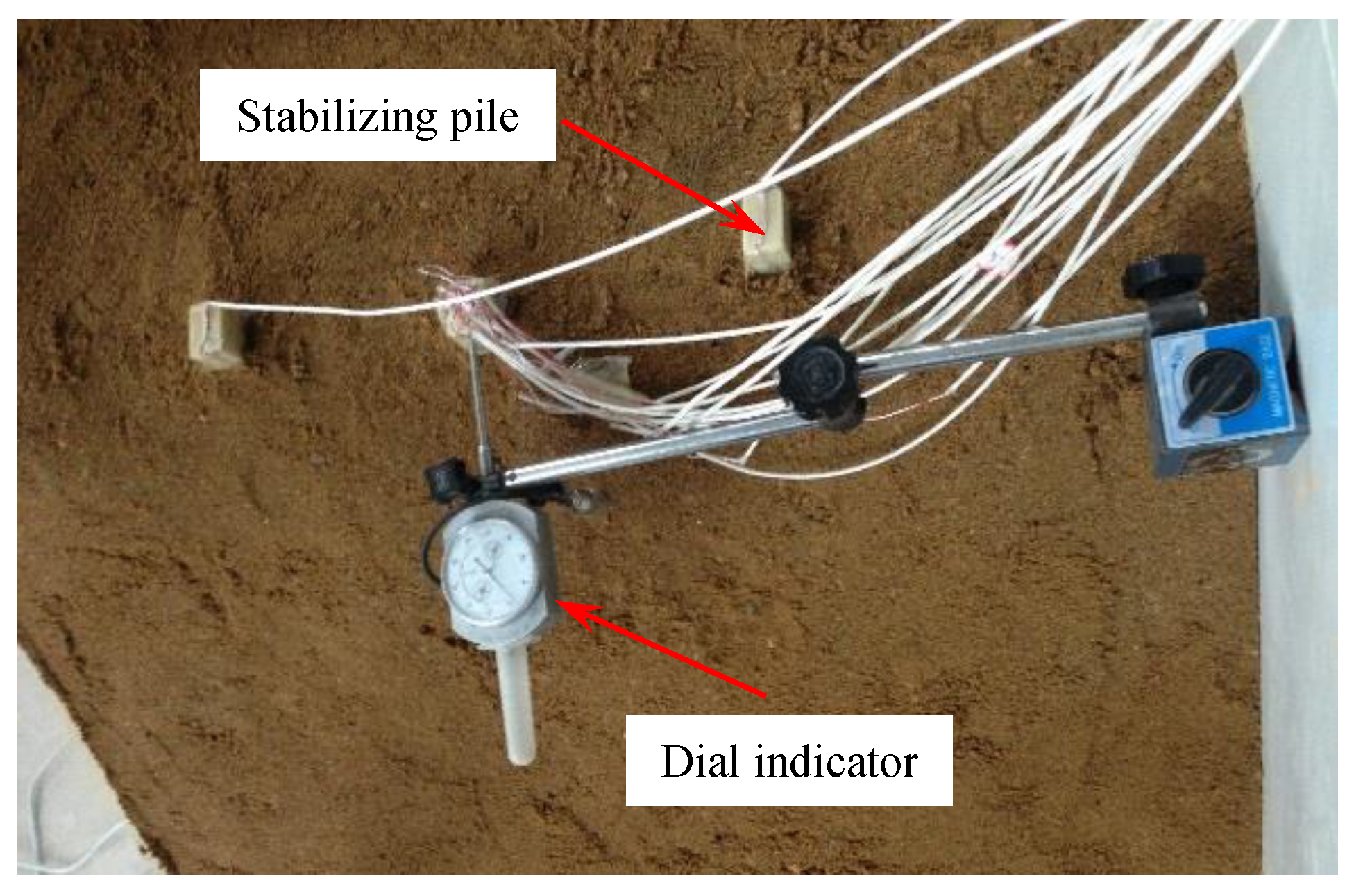
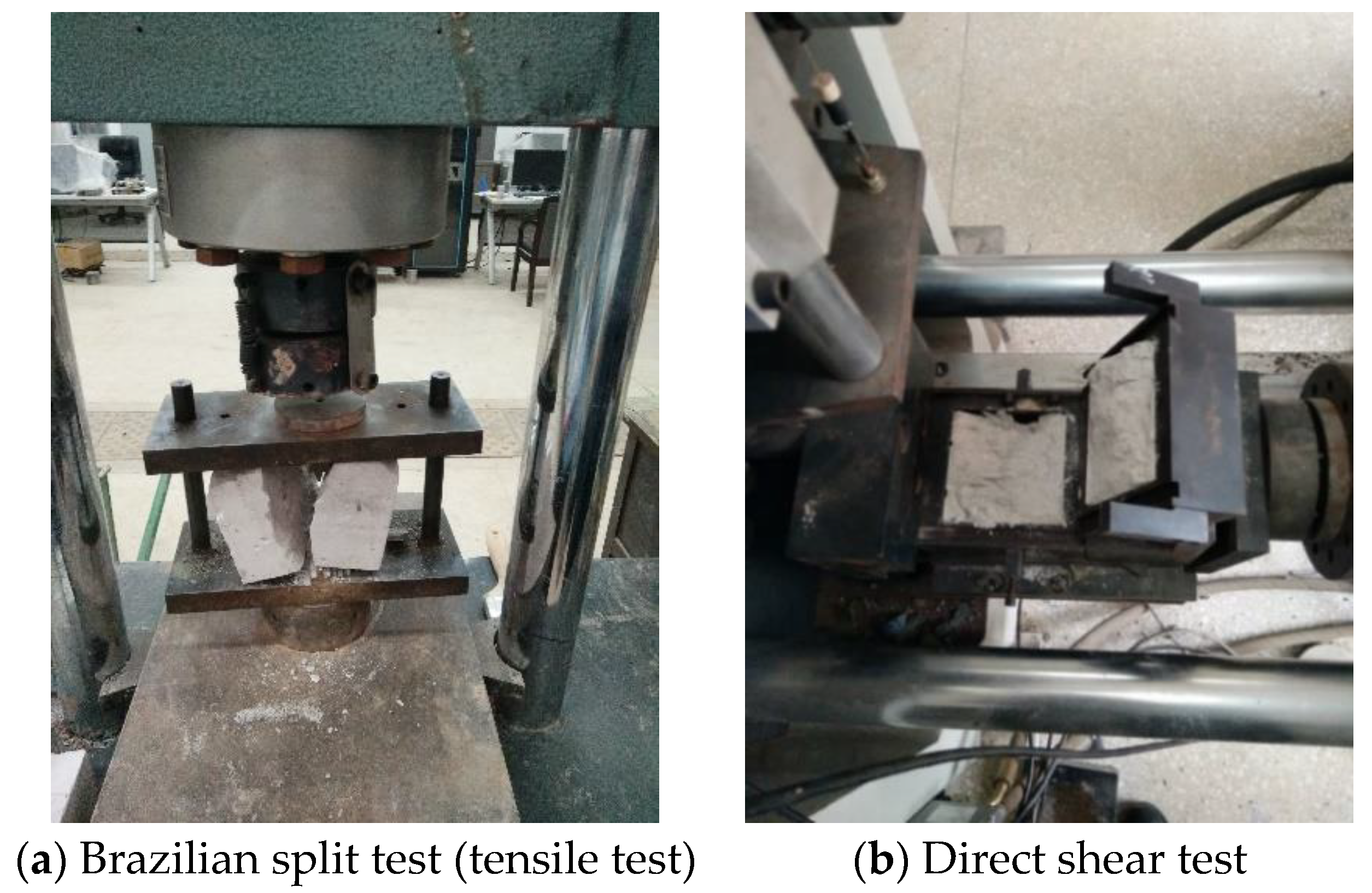



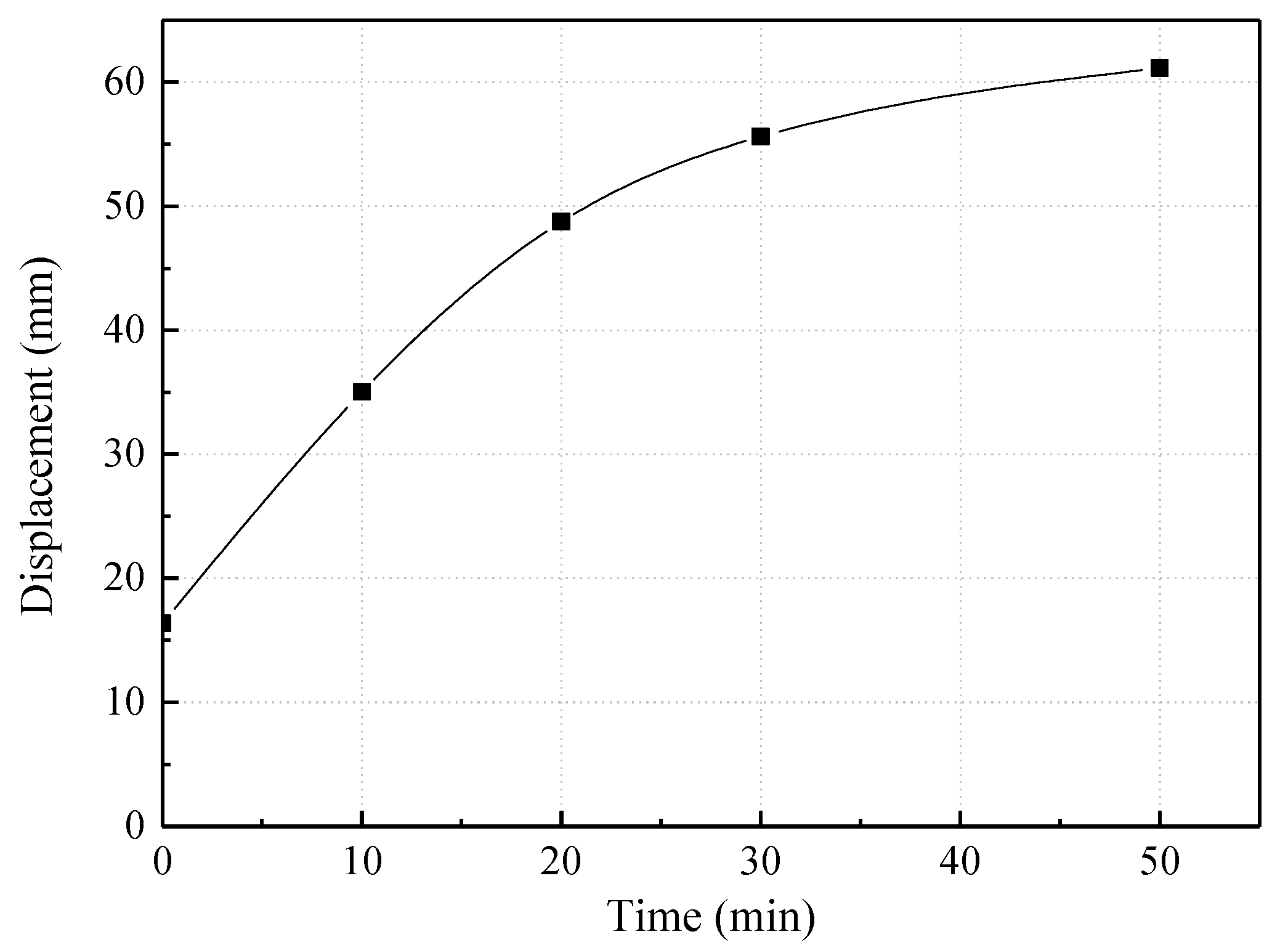
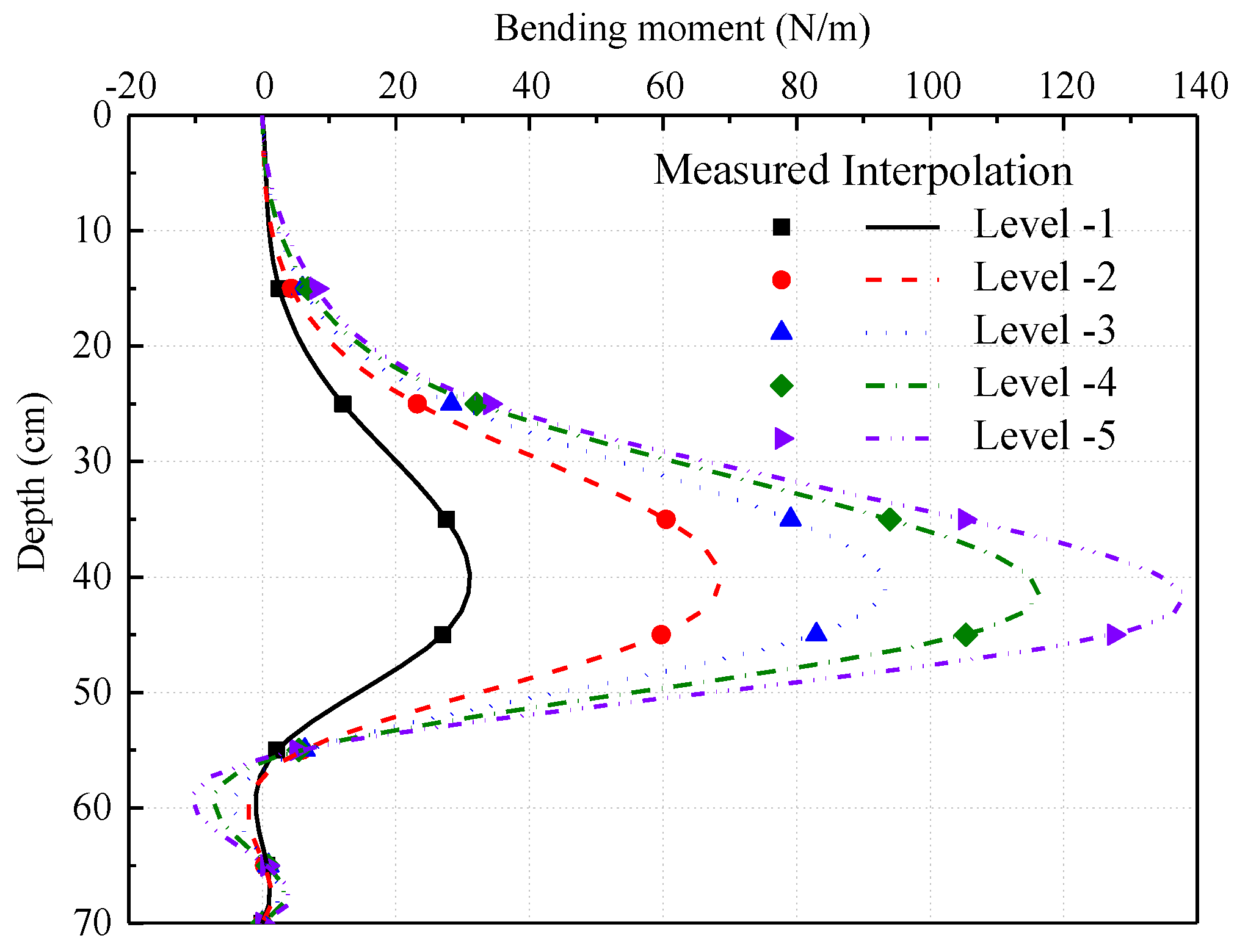
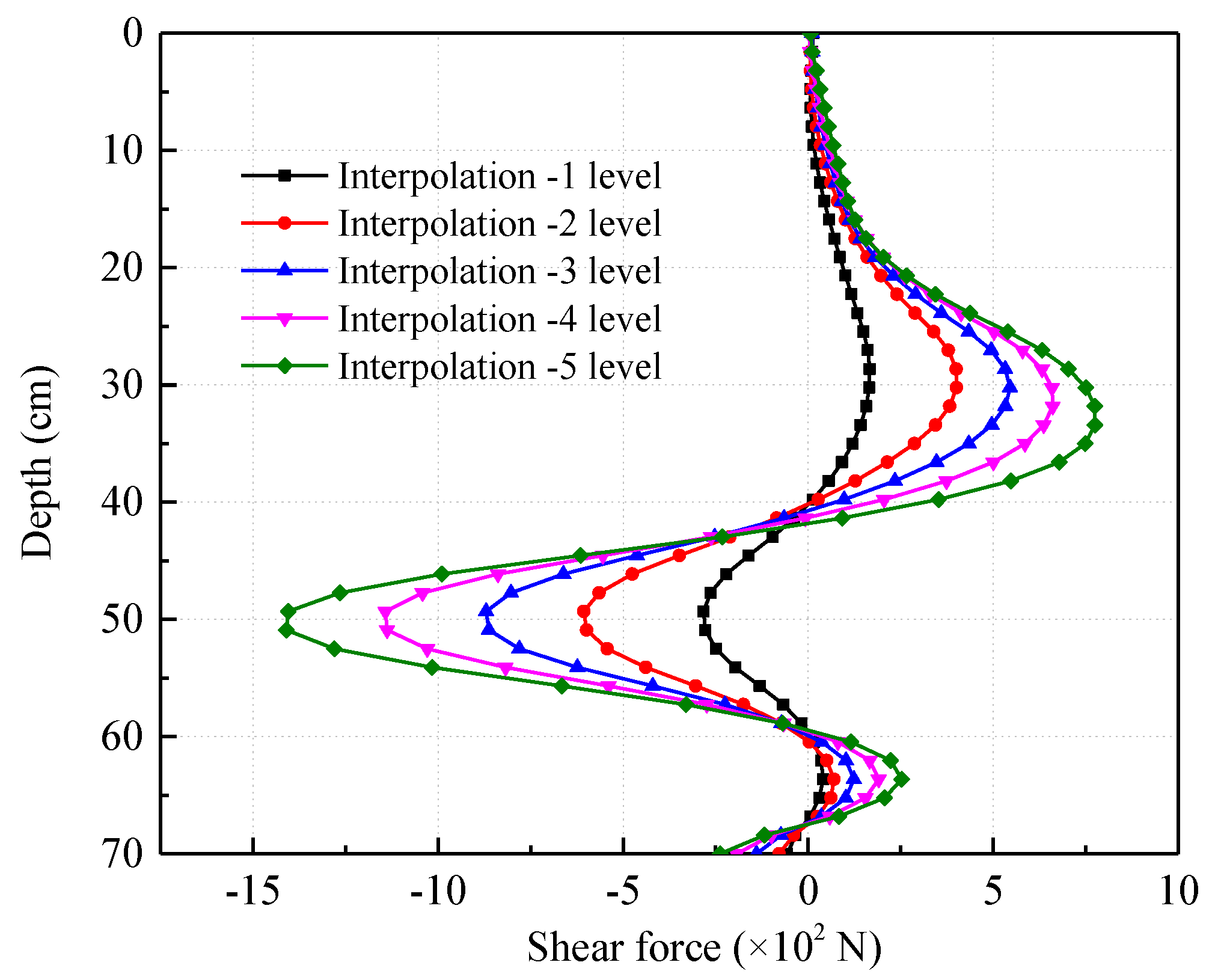
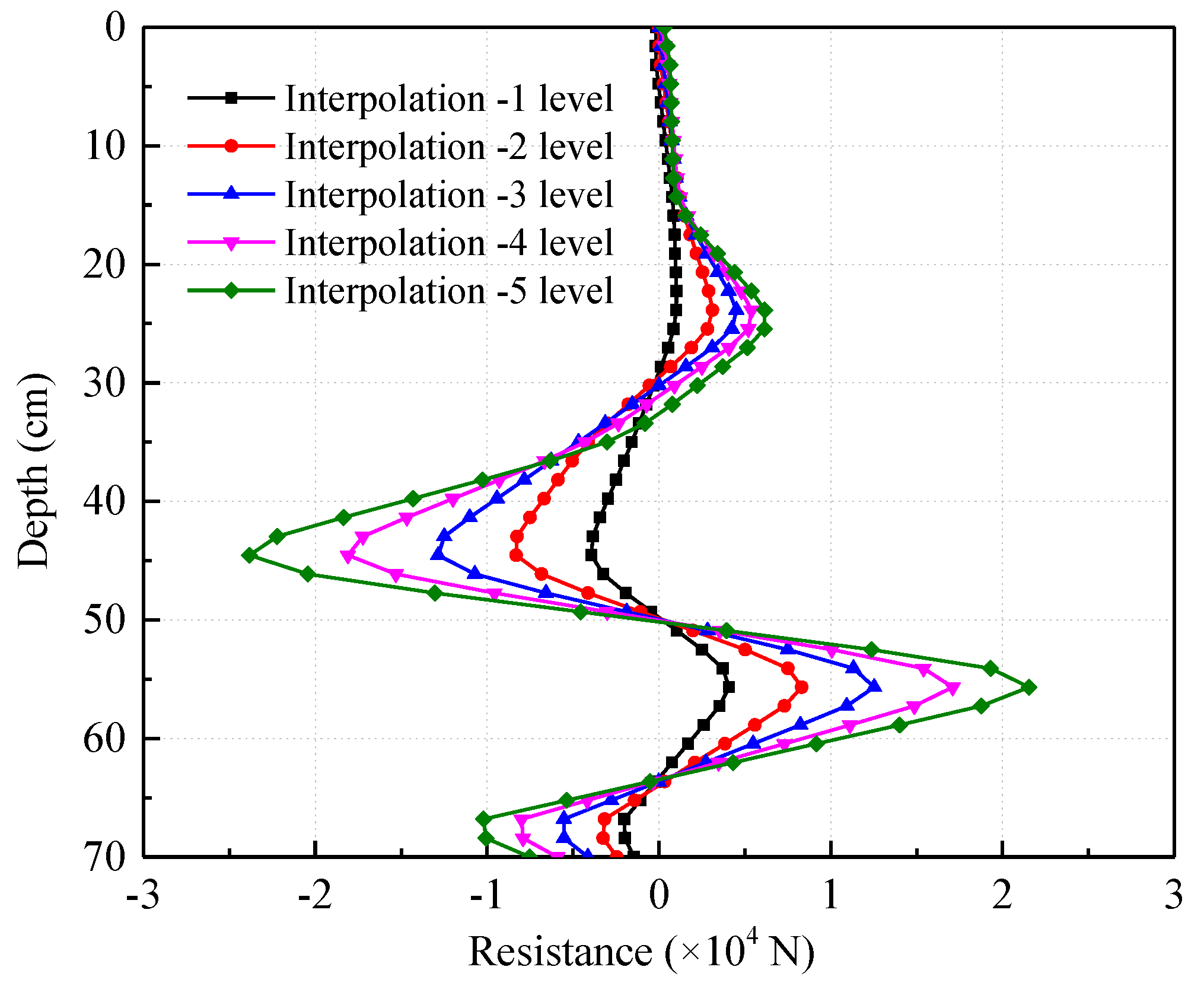
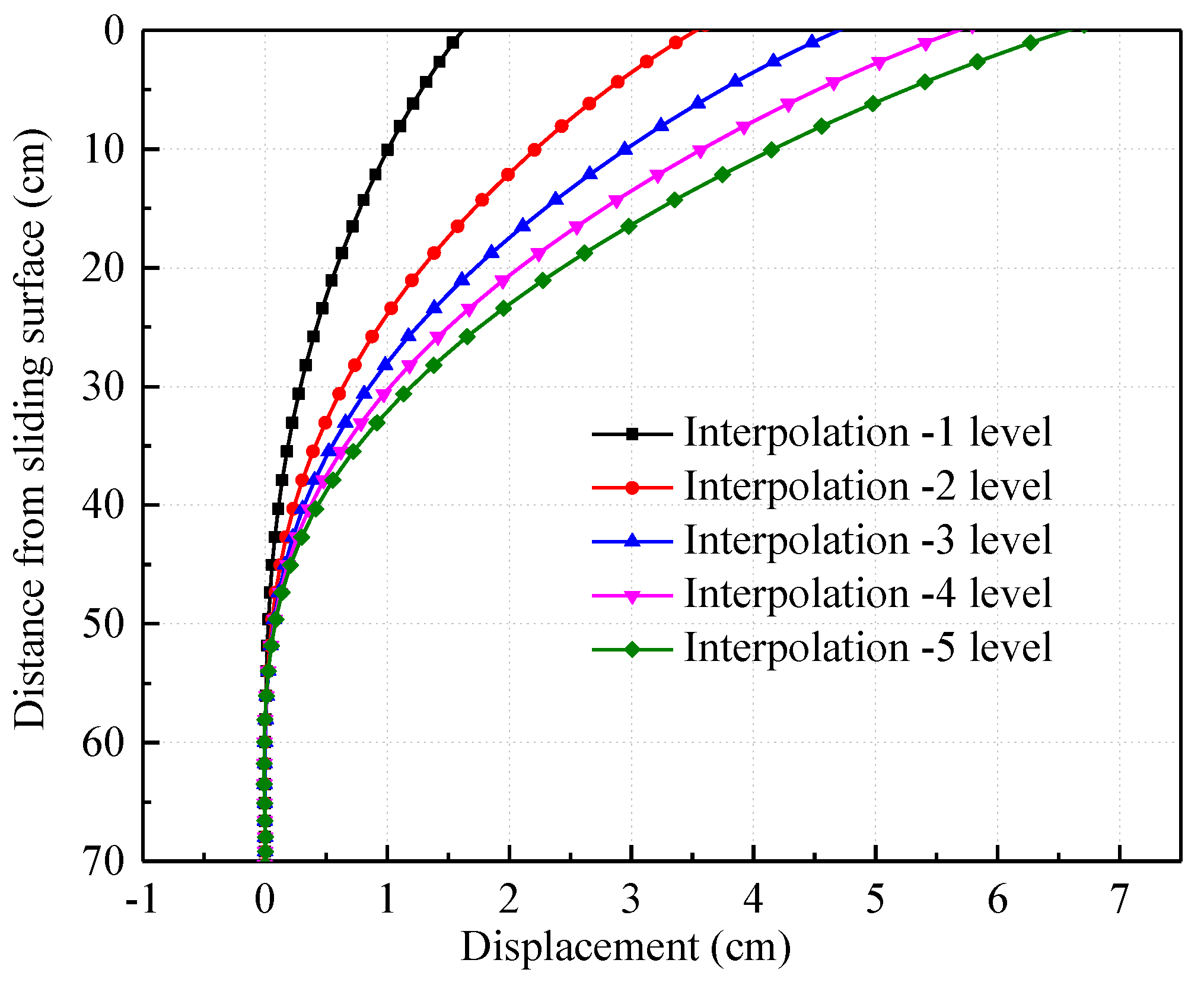


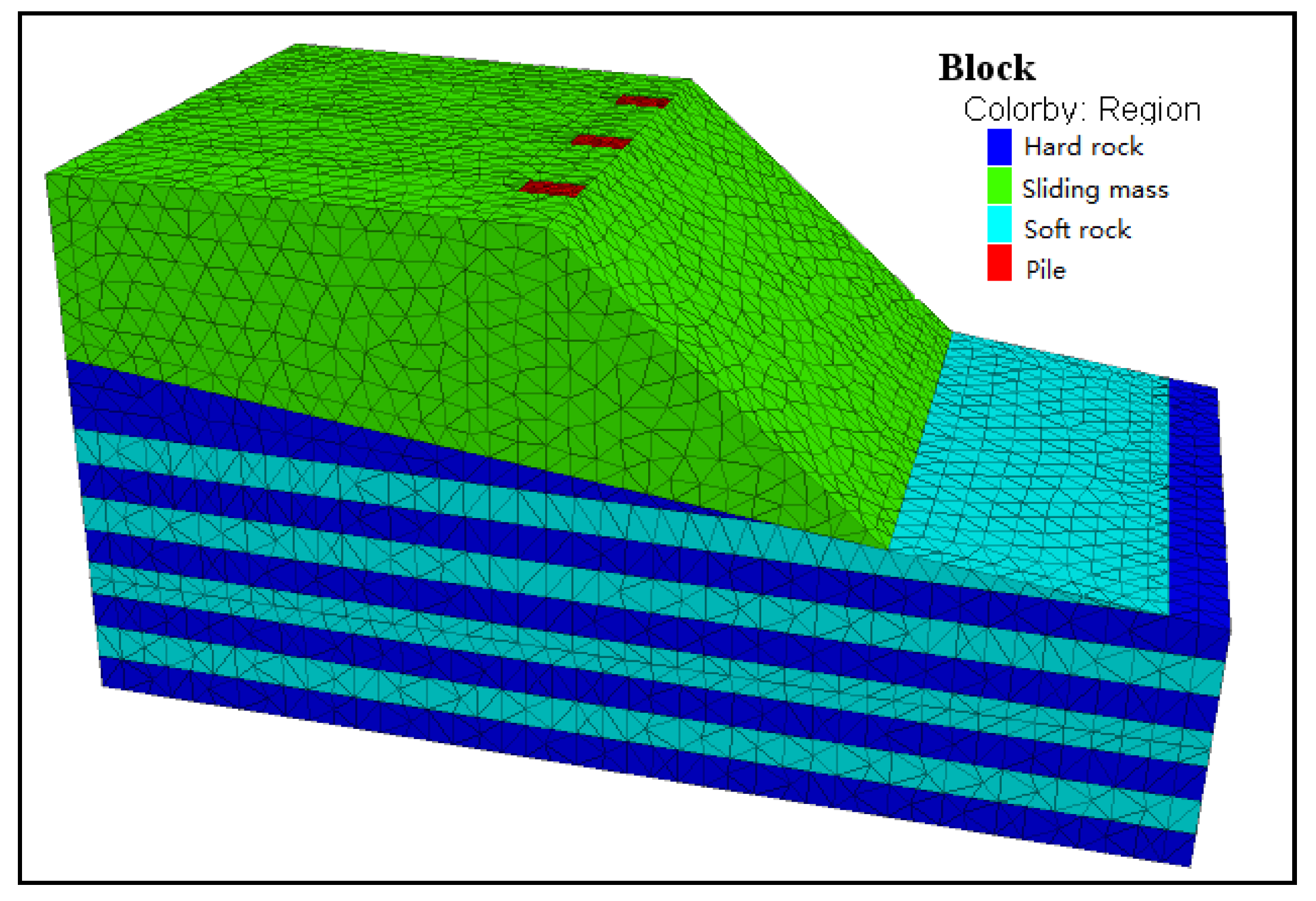
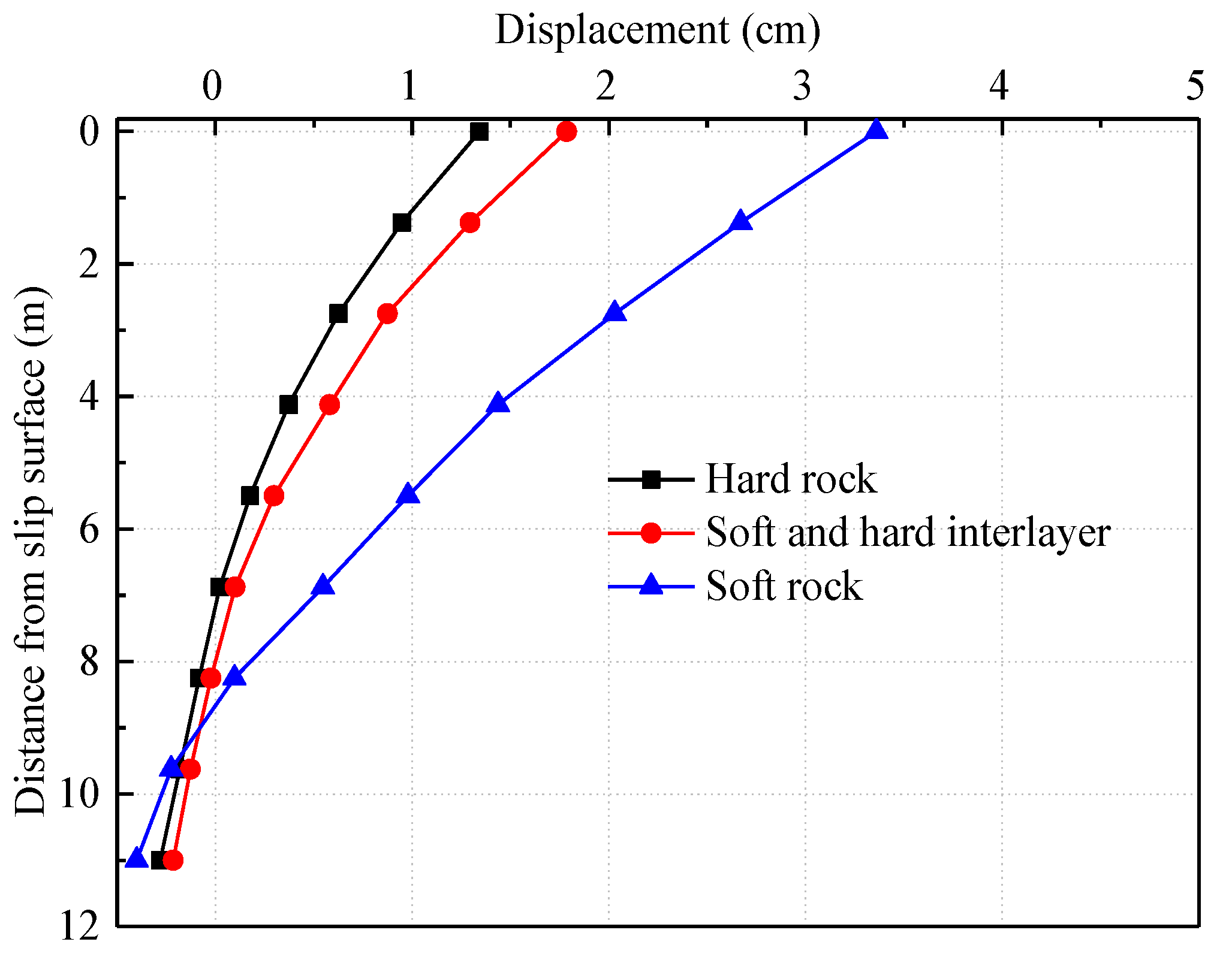
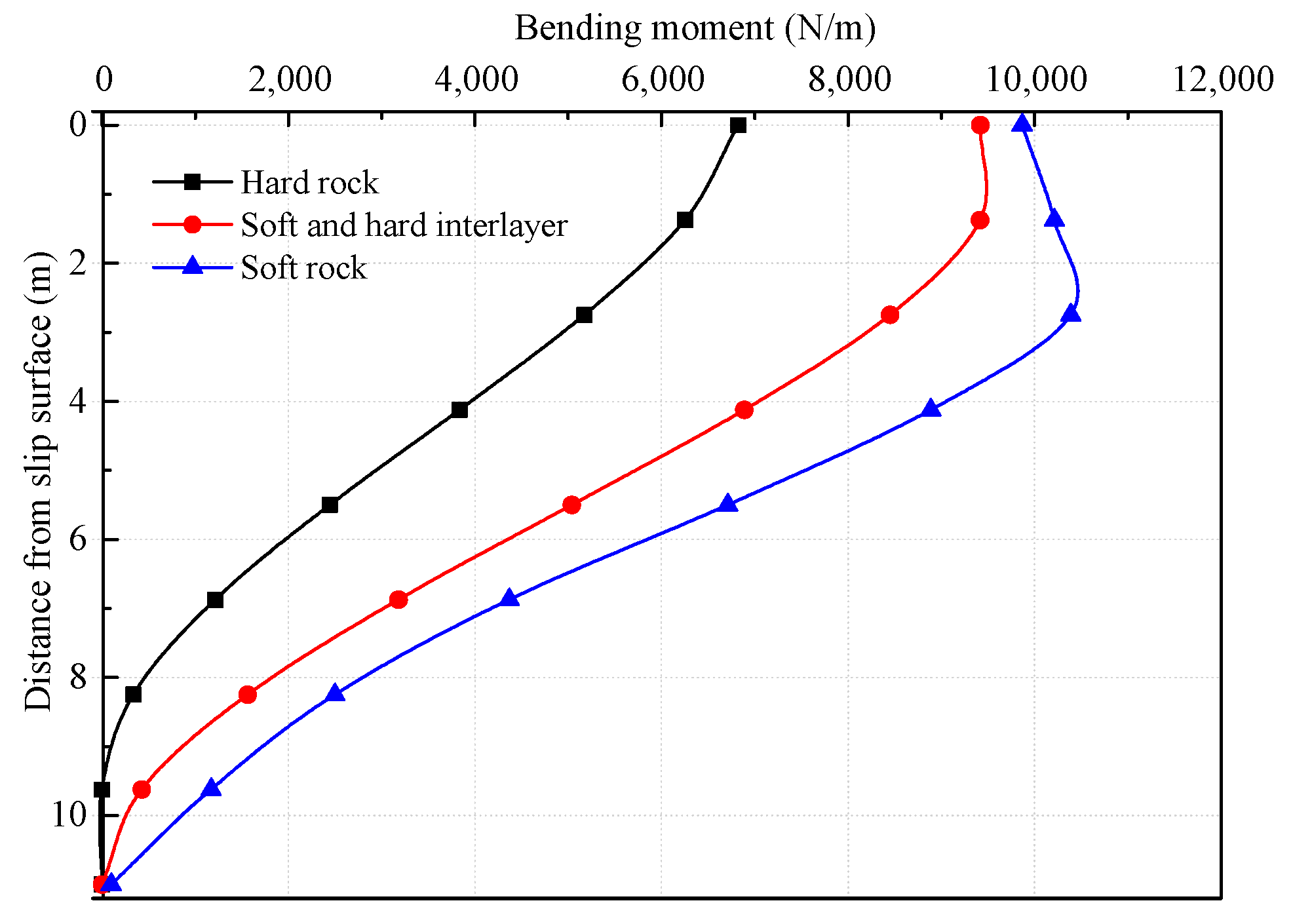
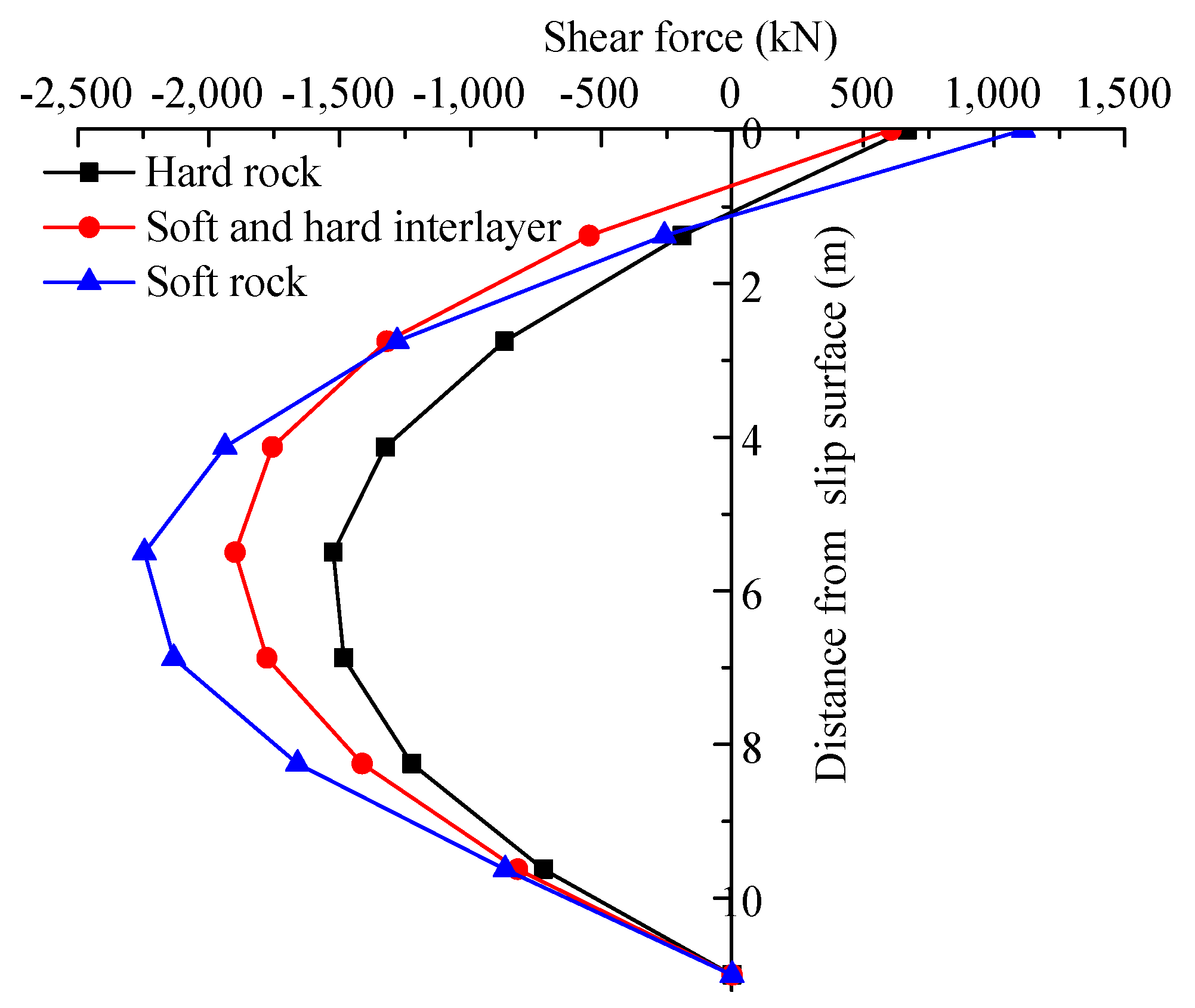
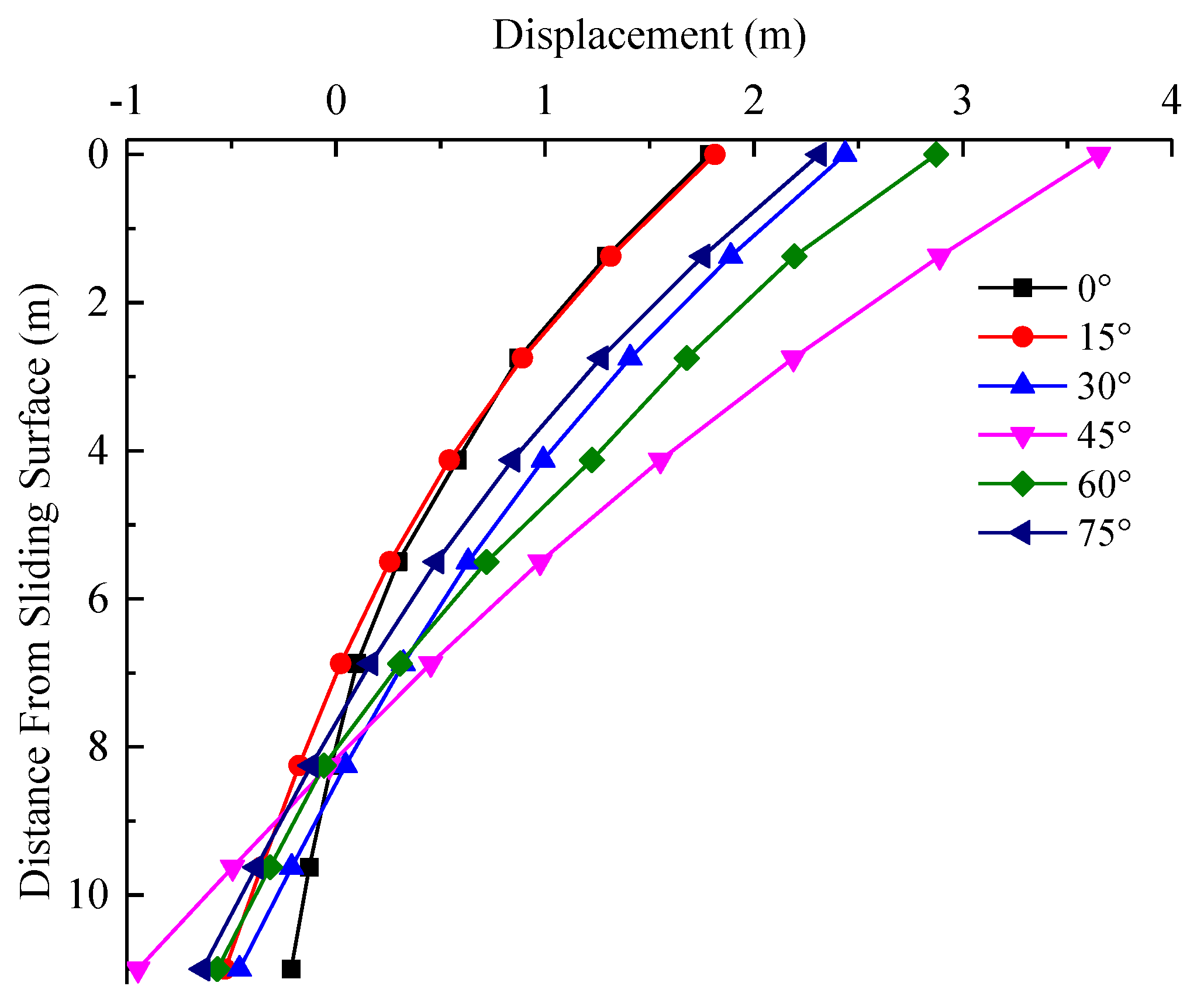
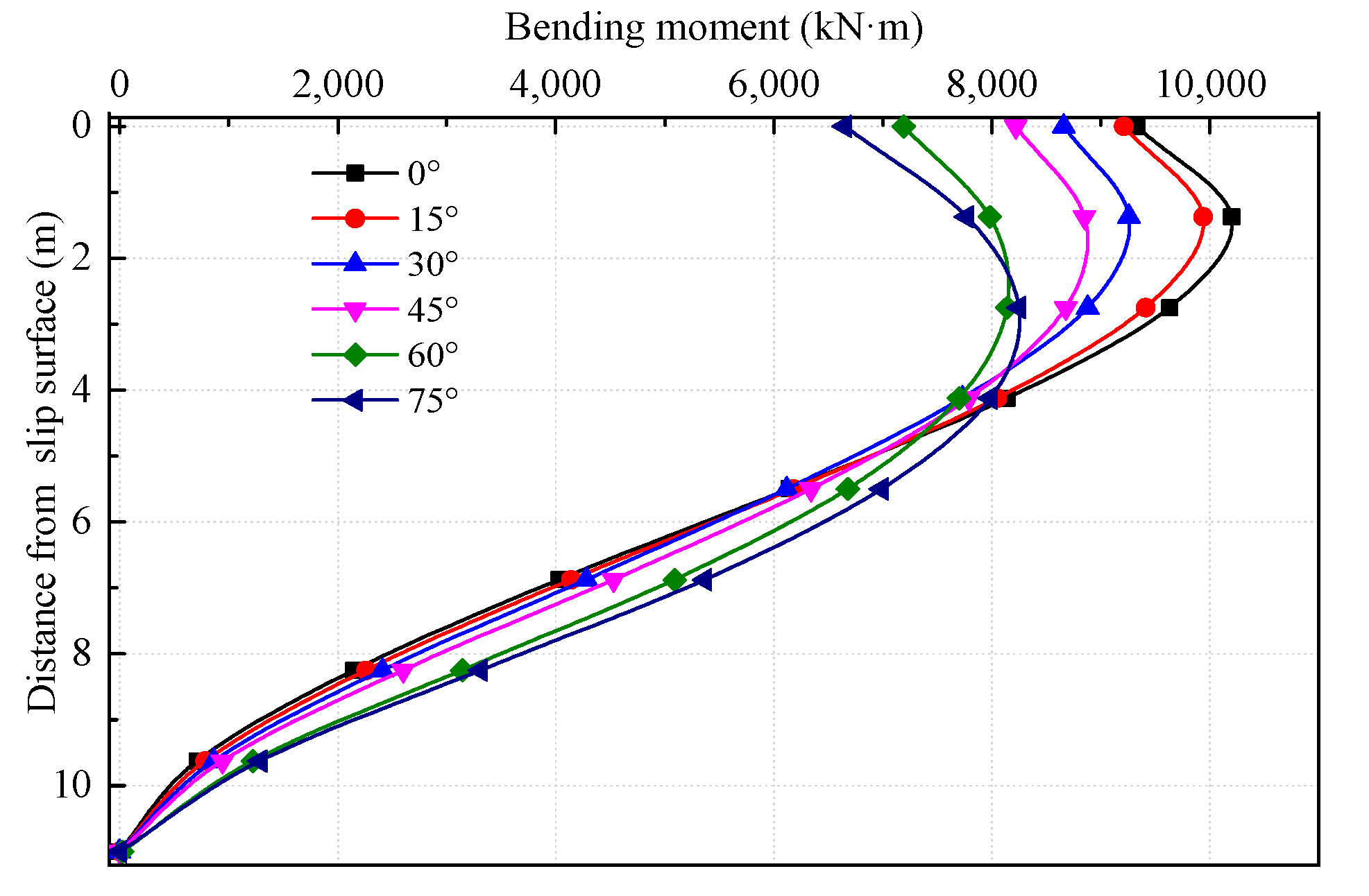
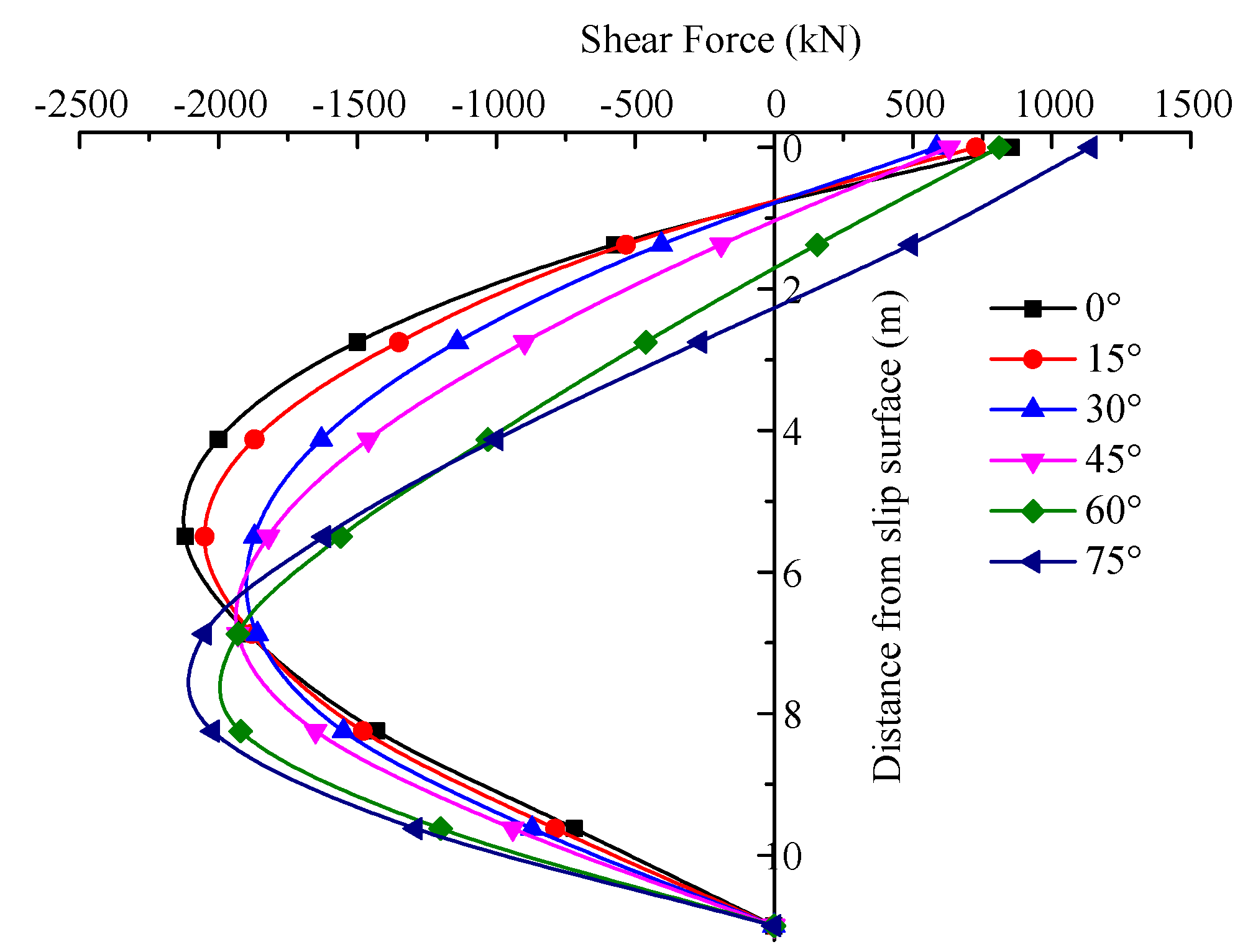
| Rock Type | Density ρ (g/cm3) | Elastic Modulus E (GPa) | Poisson′s Ratio μ | Cohesion c (MPa) | Friction Angle φ (°) | Tensile Strength (MPa) |
|---|---|---|---|---|---|---|
| Mudstone | 2.43 | 15.3 | 0.27 | 2.99 | 33.3 | 2.8 |
| Sandstone | 2.63 | 27.3 | 0.16 | 6.63 | 50.4 | 4.9 |
| Parameter | Bedding Plane | ||
|---|---|---|---|
| Mudstone | Sandstone | Sandstone-Mudstone | |
| Cohesion c (MPa) | 0.35 | 0.45 | 0.24 |
| Friction angle φ (°) | 30.36 | 38.56 | 33.8 |
| Rock Type | Density ρ (g/cm3) | Elastic Modulus E (GPa) | Poisson′s Ratio μ | Cohesion c (kPa) | Friction Angle φ (°) |
|---|---|---|---|---|---|
| Stabilizing pile | 2150 | 1.68 | 1.16 | 1300 | 22 |
| Sliding body | 1870 | 0.009 | 0.02 | 24 | 15 |
| Hard rock | 2160 | 2.42 | 1.81 | 5160 | 30 |
| Soft rock | 1960 | 2.31 | 0.77 | 400 | 29 |
© 2020 by the authors. Licensee MDPI, Basel, Switzerland. This article is an open access article distributed under the terms and conditions of the Creative Commons Attribution (CC BY) license (http://creativecommons.org/licenses/by/4.0/).
Share and Cite
Dong, M.; Wang, L.; Shahbodagh, B.; Du, X.; Deng, S.; Sun, Z. Effect of the Soft and Hard Interbedded Layers of Bedrock on the Mechanical Characteristics of Stabilizing Piles. Appl. Sci. 2020, 10, 4760. https://doi.org/10.3390/app10144760
Dong M, Wang L, Shahbodagh B, Du X, Deng S, Sun Z. Effect of the Soft and Hard Interbedded Layers of Bedrock on the Mechanical Characteristics of Stabilizing Piles. Applied Sciences. 2020; 10(14):4760. https://doi.org/10.3390/app10144760
Chicago/Turabian StyleDong, Manman, Liangqing Wang, Babak Shahbodagh, Xi Du, Shan Deng, and Zihao Sun. 2020. "Effect of the Soft and Hard Interbedded Layers of Bedrock on the Mechanical Characteristics of Stabilizing Piles" Applied Sciences 10, no. 14: 4760. https://doi.org/10.3390/app10144760





